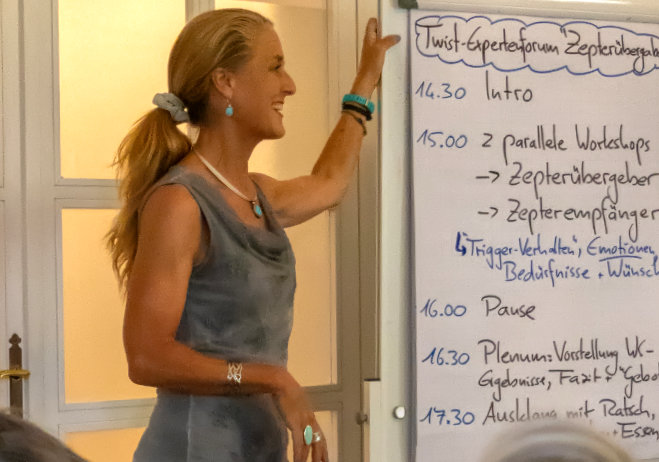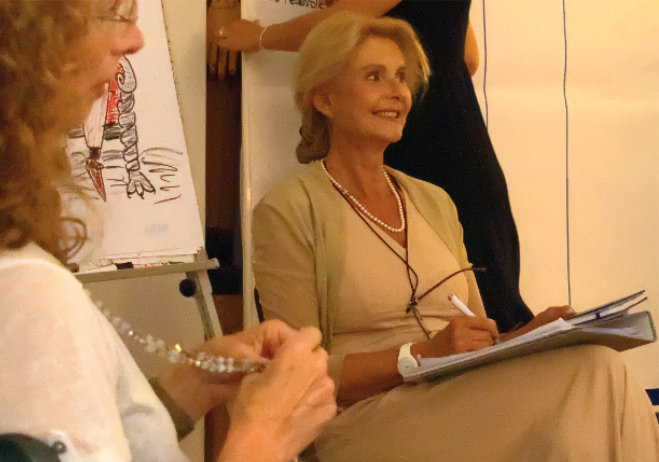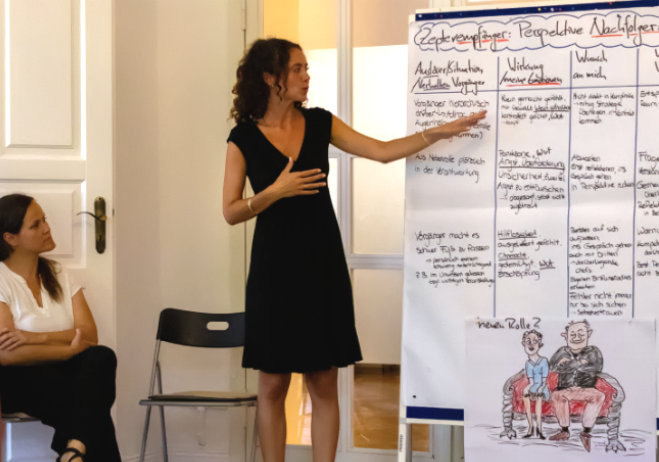Passing the Scepter
Emotions in the Process of Passing the Scepter in Companies
How can the transfer of responsibility from a (former) leader to their successor be managed in a way that is psychologically healthy for both parties?
Authors: Claudia Harss, Sonja Nitsch
Numerous publications and guides on orderly succession in leadership positions provide orientation on what needs to be considered to ensure a smooth generational transition (e.g., Sobanski & Gutmann, 1998). So why is it that both predecessors and successors often report experiencing intense emotions during the scepter-passing phase, sometimes lasting for months? In interviews and a workshop with 25 clients and consultants, the authors explored specific situations in July 2025 in which the transfer of responsibility triggered strong emotions in one of the protagonists. From this, they derive guidelines for a psychologically successful transition process. These offer practical insights for those involved and for supporting HR professionals.




Scepter Giver and Scepter Receiver
Insights from the Handover Process
In the safe space of coaching sessions, it becomes clear that the transfer of power and responsibility poses emotional challenges for both the successor and the predecessor. This is especially true during a transitional phase in which both parties are simultaneously active within the same organizational unit. Despite numerous publications on leadership transitions, few authors explicitly address this specific situation and its emotional challenges, and those who do often focus on family businesses (e.g., Maurice, 1993; Stonn, 2008; Gerke Holz Häuer, 2013; Lemar, 2014).
Although a leadership transition affects a wider circle of people from a systemic perspective, this article focuses on the two main actors: the predecessor and the successor. We examine concrete everyday situations in the responsibility transfer process (symbolically “the scepter”) and the emotions that arise on both sides. To improve readability, we refrain from gender-neutral language and alternate between feminine and masculine forms.
The relevance of this topic became clear during test interviews with eleven leaders who had already experienced a scepter handover from one of the two perspectives (predecessor or successor). Our interviewees became emotional when recalling the behavior of their predecessor or successor during the transition phase. In a “Scepter Handover” workshop with 25 clients and consultants in July 2025, we explored the topic further. In two groups, each reflecting on personal experiences as either predecessor or successor, we initially collected critical situations that had “triggered” strong emotions in one of the two protagonists during the handover process. Both predecessors and successors spontaneously cited situations that had elicited negative emotions more frequently.
Of particular interest was the fact that feelings of powerlessness were equally prominent for both protagonists. Neither the outgoing leader nor their successor appeared to feel confident and secure during the transition. At the same time, both implicitly assumed that the other felt overpowered.
The Successor’s Perspective
„You’re keeping me small!“
The trigger situations that evoked strong emotions in the successor during interactions with the predecessor can be grouped into the following five thematic blocks:

- The Predecessor’s Perspective: Cannot or Will Not Let Go, e.g.: „Let me read all the proposals again, just to be safe!“
- Officially on equal footing – but still behaving like a superior, e.g.: „His behavior toward me didn’t change after I was promoted to the circle of department heads. In front of all colleagues, he said to me: ‘Please prepare a protocol for us by next week, Ms. X!“
- Overwhelming ad-hoc assignments, e.g.: My boss got sick and asked me to represent her at a conference in London in just two days! Without enough time to prepare, I flew out and completely failed to make a good impression as Germany’s future international contact.“
- You do it… and then he does it himself anyway, e.g.: „You’re in the lead!’ my predecessor said. Right. Fifteen minutes in, in the middle of my presentation, the client asked a question. After that, only the two of them spoke. I was left standing by the projector like someone forgotten.“
- Subtle competition and dominance until the very end, e.g.: „In the last weeks while my predecessor was still there, we had a latent power struggle: Who has the final word? Who sits in which chair? Whose idea prevails? Who gets to open or close a meeting?“
The emotions triggered by these situations revealed the opposite of what one would hope for under the keyword “empowerment” – motivation and strengthening for a successor:
- Feeling diminished: How am I supposed to make my mark next to this giant ego? He clearly doesn’t trust me at all! Am I really that incompetent?
- Powerlessness and helplessness: along with the feeling of being at the mercy of the predecessor, as long as they hold the upper hand and claim the final word.
- Humiliation: when treated like an assistant in front of others or put in one’s place.
- Fear of failure: even panic, fearing to fall short of expectations and not being allowed to make mistakes to avoid disappointing the predecessor.
- Feeling exhausted, exploited, and mocked: when you are already “running the show” and the predecessor takes credit for it.
- Strained patience and anger: He will never let me do it! On December 31, I was supposed to take over the CEO office, but when I returned from ski vacation in January, he was still there saying: “You don’t mind, right? My consulting contract runs until March!”
- Ambivalence, when repeatedly refraining from giving long-overdue feedback to the predecessor, out of not wanting to “bite the hand that fed me.”
The Predecessor’s Perspective:
„You’re keeping me small!“
A look at the trigger situations from the predecessor’s point of view shows that even the “current scepter holders” do not feel as powerful in the handover process as one might think. Typical trigger situations can also be grouped into five thematic blocks:

- Knowledge and Experience of the Predecessor Are Not Sought, e.g.: "When the pitch went badly the other day and I heard the client’s reasoning, I thought: This could have been avoided – why didn’t you ask me or involve me beforehand?"
- The Successor Takes Credit for Others’ Work, e.g.: "She presented the entire project as if it had been entirely her idea and never once mentioned me, even though I was the initiator and driving force behind the project for four years!"
- Different Approaches, e.g.: "In some areas, we don’t align on the approach, and employees don’t give honest feedback because they don’t want to upset either of us."
- Indirect Hints – ‘You’re outdated’, e.g.: "That’s done differently today!" “What, you don’t know this yet?” “Shall I do it for you so it goes faster?”
- Latent or Open Devaluation of the Predecessor’s Work, e.g.: "In her inaugural speech, my successor publicly stated that a lot had been neglected in the past, which she now finally wanted to address!"
For the predecessors interviewed, it makes sense to distinguish whether they are facing another career step or the end of their professional life. In the first case, aggressive feelings are more common; in the second case, depressive feelings tend to dominate, as illustrated by the following examples:
- Competition, aggression, and hypersensitivity, when the position previously held is (perceived as) claimed too early and assertively by the successor.
- Frustration over avoidable mistakes, which could have been prevented if the successor had asked before acting recklessly.
- Disappointment and anger, when it is reported via third parties that the predecessor is considered primarily responsible for everything that went wrong in the past.
Especially for those who handed over the scepter permanently before retirement, the feeling of being discarded and devalued predominated:
- Perceived devaluation, loss of power and significance, due to the successor not appreciating the predecessor’s achievements.
- Hurt feelings, when one is no longer invited or included in email lists, messages go unanswered for days, or assigned tasks are given low priority.
- Boredom and feeling useless, when task after task is handed over without replacement.
- Worry, that things will go worse without them, projects will fail, and clients or key performers will leave.
- Grief, over leaving familiar work, team, and long-term colleagues.
- Fear, self-doubt, and disorientation, coupled with the feeling of not having yet arrived in the new role or life phase, suddenly feeling weak where one previously always felt strong.
The Rewarding View on Hidden Needs Behind the Emotions
To guide the workshop toward a constructive solution amid all these negative emotions, we asked participants which personal needs were neglected in the trigger situations. Even though predecessors and successors were interviewed separately, very similar responses emerged:
• The need for empathy, respect, and appreciative treatment, the desire to make a meaningful contribution and feel needed, and mutual trust to rely on agreements made.
• Successors additionally expressed the need to experiment with new ideas and approaches without unnecessary restrictions or excessive fear of mistakes.
Interestingly, many participants became reflective when asked about their own needs underlying the negative emotions. In the workshop, the atmosphere relaxed and became noticeably calmer and more constructive. The focus shifted from self-assertion to self-care. This was crucial for the next step: reflecting on how one could have expressed their needs more effectively in hindsight. Almost all participants indicated that, looking back, they would be less likely to react immediately with aggression or withdrawn hurt. In most cases, it would have been better to first reflect and then communicate their needs openly and honestly on an equal footing.
Results
Tips and Guidelines for Those Involved and HR Professionals
In the final step of the workshop, guidelines and tips were developed, including recommendations for HR departments and external consultants.
What Predecessors Can Keep in Mind:
- Learning to Let Go: Saying goodbye to the familiar role of leader can be emotionally challenging. During the internal change process, it can help to recall when and how you successfully managed a handover before.
- Clear Ground Rules and a Timeline: Agree with the successor on a timeline for gradually transferring responsibilities, as well as rules (transparent to others) about who is the contact for what and until when, and stick to them yourself!
- “Flexibility Exercises” in the Face of New Ideas and Approaches: Be open to the successor’s new ideas, take a genuine interest, and ask questions before criticizing or reflexively rejecting the change.
- Tolerance for Mistakes: Even if you are still officially responsible, dare to hand over important tasks. Saying “You can handle this!” strengthens and motivates the successor and builds trust (also externally).
- Symbolic Separation of Territories: Do not remain in your CEO office once the successor has officially taken over. Find a “home base” where you can still be approached and consulted while you are still on board.
Encouragement and Tips for Successors:
- Try to Stay Polite and Appreciative: Our case studies show clearly that the predecessor is often just as uncertain as you are. Thinking and speaking more in terms of “we” rather than “I” makes it easier for them to hand over the spotlight.
- Understand the Old Before Introducing the New: Make sure you understand the underlying logic and history of certain processes before changing them.
- Set Realistic Expectations for Yourself: Release the pressure to understand everything immediately and manage it perfectly. In your new role, you are a beginner, you will make mistakes, and you are allowed to ask all the questions you have.
- Step Out of the Employee Role: Treat your predecessor as an equal. Be honest and polite if you don’t have time, or ask for collegial advice if you feel overwhelmed by a task.
- Engage the Predecessor as a Mentor and Coach: When you feel professionally and personally ready for the next challenge, explicitly ask the predecessor to represent you in important tasks or committees and give you tips beforehand.
An important insight from the “ten commandments” is obvious: it makes sense for both protagonists to consciously let go of their usual roles and the expectations associated with the other during the scepter handover phase. The familiar role distribution (superior on one side, employee on the other) no longer fits during the transition. A helpful alternative is the guiding principle of a team of two responsible individuals acting on equal footing and shaping the leadership transition together, ensuring that employees and tasks continue to be optimally managed in the future.
Conclusion for HR Professionals and External Consultants
"The technical aspect of the scepter handover is easy – the emotional aspect is quite tricky!" summarized a former HR director of a chemical company during the TWIST workshop. Internal and external consultants are called upon to pay closer attention to this “blind spot.” A psychologically informed support approach for both protagonists and the affected team during the handover process makes particular sense. Such support should cover logical aspects, like scheduling, but also give much greater consideration to the psychological side of succession by bringing expectations and needs to the table, encouraging perspective shifts, and collaboratively developing ground rules for the transition period.
At the end, the conclusion of the process should be recognized with a “scepter handover” celebration. If a symbolic object (e.g., the key to the company headquarters or the CEO’s office) is presented before the assembled staff, it creates a profound emotional realization for all participants that one phase is ending and a new one is beginning.
For those leaders who face “well-deserved retirement” after handing over to their successor, letting go is often particularly difficult. Support from a coach, starting several months before retirement, who helps find meaningful tasks and content for the next life phase (transition coaching), can significantly ease the process of releasing responsibility for the predecessor.
Finally, one may ask: can all the emotional stress be avoided if the successor only steps in once the predecessor has left? The author and expert on generational change in family businesses, Dr. Bernd Lemar, whom we consulted, offered the following rule of thumb: the more complex and experience-dependent the task, the longer the natural overlap between predecessor and successor should be. If both protagonists get along well (and unfortunately, only then), this is a great advantage for a very effective transfer of experience and know-how. Lemar reflects after nearly 40 years of consulting work:
"If you truly commit to it, helping a talented successor take the reins is a very meaningful and fulfilling task!"

